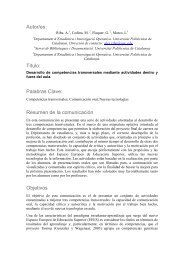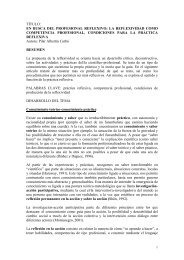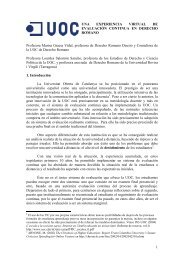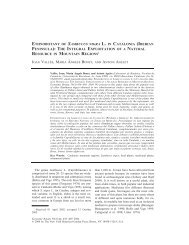Impaginato 5.p65 - Universitat Rovira i Virgili
Impaginato 5.p65 - Universitat Rovira i Virgili
Impaginato 5.p65 - Universitat Rovira i Virgili
Create successful ePaper yourself
Turn your PDF publications into a flip-book with our unique Google optimized e-Paper software.
EVIDENCE IN FAVOR OF THE PALAEOLITHIC CONTINUITY REFUGIUM THEORY (PCRT)<br />
113<br />
there are colorful, albeit rather grotesquely proportioned, figures that go by the<br />
name of azaku-zaharrak, where the second element is the plural of zahar «old». 23<br />
The phonological erosion suffered by the expression might have developed as<br />
follows: hamalau-zaingo-zaharrak > *(hama)lau-za(in)ko-zaharrak ><br />
*lauzaku-zaharrak > azaku-zaharrak.<br />
It was not until the 1970s that these characters were recuperated in Lesaca<br />
and their name re-introduced, after nearly a forty year hiatus, given that during<br />
the Franco period the characters were absent. 24 Today the performers’ appearance<br />
is manipulated so as to make them appear extremely bulky, larger than life,<br />
similar to En Peirot of Catalunya, a character we will examine in more detail<br />
shortly. In order to achieve this effect, the actors stuff their costumes with straw,<br />
while the costumes themselves are made out of gunny sacks. As a result, the<br />
expression azaku-zaharrak ([Ihauteriak] 1992) has undergone further<br />
phonological erosion and semantic reanalysis, being reduced, at least by some<br />
writers, to zaku-zaharrak, and interpreted, erroneously, as meaning «sacos viejos»<br />
(«old sacks») as if the first element corresponded to the old gunny sacks used to<br />
make the costumes.<br />
Fig. 21. Lesaka Zaku Zaharrak, 2007.<br />
Source: http://www.flickr.com/photos/dantzan/724934332/in/set-72157600656899313/.<br />
23 Cf. http://www.flickr.com/photos/dantzan/724061073/.<br />
24 Even earlier, there was no specific date for when the zaku-zaharrak were supposed to appear,<br />
rather from January 6 th until the beginning of Carnival the various groups of performers would<br />
take turns coming out into the streets. Then on the Monday of Carnival all the groups of performers<br />
would come together, which could produce rivalries between the zaku-zaharrak of the various<br />
wards of the village ([diariodenavarra.es] n.d.).
















